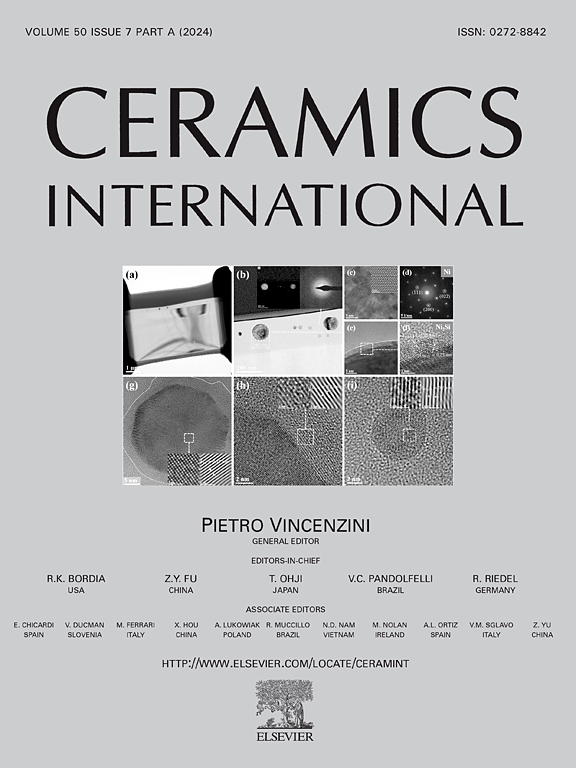原位合成硼酸铝空心晶须增强磷酸铝波透明陶瓷
IF 5.6
2区 材料科学
Q1 MATERIALS SCIENCE, CERAMICS
引用次数: 0
摘要
磷酸铝陶瓷作为一种波透明陶瓷材料,具有优异的电学性能和热学性能。然而,由于机械性能不足,其在航空航天领域的应用往往受到限制。通过原位合成将Al5BO9空心晶须引入到AlPO4陶瓷中。通过引入原位空心晶须和优化晶须分布,显著提高了材料的力学性能。本研究利用Frank的毛细平衡理论解释了晶须中空结构的形成机制。随后,通过周期键链理论讨论了氧化硼的传质过程,从而在AlPO4基体上原位合成了壁厚和管径约为700 nm的空心晶须团簇。增强后的复合材料具有优异的力学性能,其抗折强度达到347 MPa,与外部Al5BO9晶须增强的AlPO4陶瓷相比,机械强度提高了61.17%,同时保持了磷酸铝的固有介电性能。综上所述,本研究提出了一种高强度、波透明的Al5BO9/AlPO4复合材料。本文章由计算机程序翻译,如有差异,请以英文原文为准。
In situ synthesised aluminium borate hollow whiskers reinforced aluminium phosphate wave-transparent ceramics
As one of the wave-transparent ceramic materials, aluminium phosphate ceramics has excellent electrical and thermal properties. However, its application in aerospace is often limited due to insufficient mechanical performance. Al5BO9 hollow whiskers are introduced into AlPO4 ceramics via in situ synthesis. The mechanical of the material was significantly enhanced by introducing in situ hollow whiskers and optimising whisker distribution. This work explains the formation mechanism of whisker hollow structures using Frank's capillary equilibrium theory. Subsequently, the mass transfer process of boron oxide is discussed through the periodic bond chain theory, leading to the in situ synthesis of hollow whisker clusters with wall thickness and tube diameter of approximately 700 nm from an AlPO4 matrix. The enhanced composite exhibited excellent mechanical performance, with a flexural strength of 347 MPa, representing a 61.17 % improvement in mechanical strength compared with AlPO4 ceramics enhanced by external Al5BO9 whiskers, while maintaining the intrinsic dielectric properties of aluminium phosphate. In conclusion, this study proposes a high-strength and wave-transparent Al5BO9/AlPO4 composite material.
求助全文
通过发布文献求助,成功后即可免费获取论文全文。
去求助
来源期刊

Ceramics International
工程技术-材料科学:硅酸盐
CiteScore
9.40
自引率
15.40%
发文量
4558
审稿时长
25 days
期刊介绍:
Ceramics International covers the science of advanced ceramic materials. The journal encourages contributions that demonstrate how an understanding of the basic chemical and physical phenomena may direct materials design and stimulate ideas for new or improved processing techniques, in order to obtain materials with desired structural features and properties.
Ceramics International covers oxide and non-oxide ceramics, functional glasses, glass ceramics, amorphous inorganic non-metallic materials (and their combinations with metal and organic materials), in the form of particulates, dense or porous bodies, thin/thick films and laminated, graded and composite structures. Process related topics such as ceramic-ceramic joints or joining ceramics with dissimilar materials, as well as surface finishing and conditioning are also covered. Besides traditional processing techniques, manufacturing routes of interest include innovative procedures benefiting from externally applied stresses, electromagnetic fields and energetic beams, as well as top-down and self-assembly nanotechnology approaches. In addition, the journal welcomes submissions on bio-inspired and bio-enabled materials designs, experimentally validated multi scale modelling and simulation for materials design, and the use of the most advanced chemical and physical characterization techniques of structure, properties and behaviour.
Technologically relevant low-dimensional systems are a particular focus of Ceramics International. These include 0, 1 and 2-D nanomaterials (also covering CNTs, graphene and related materials, and diamond-like carbons), their nanocomposites, as well as nano-hybrids and hierarchical multifunctional nanostructures that might integrate molecular, biological and electronic components.
 求助内容:
求助内容: 应助结果提醒方式:
应助结果提醒方式:


